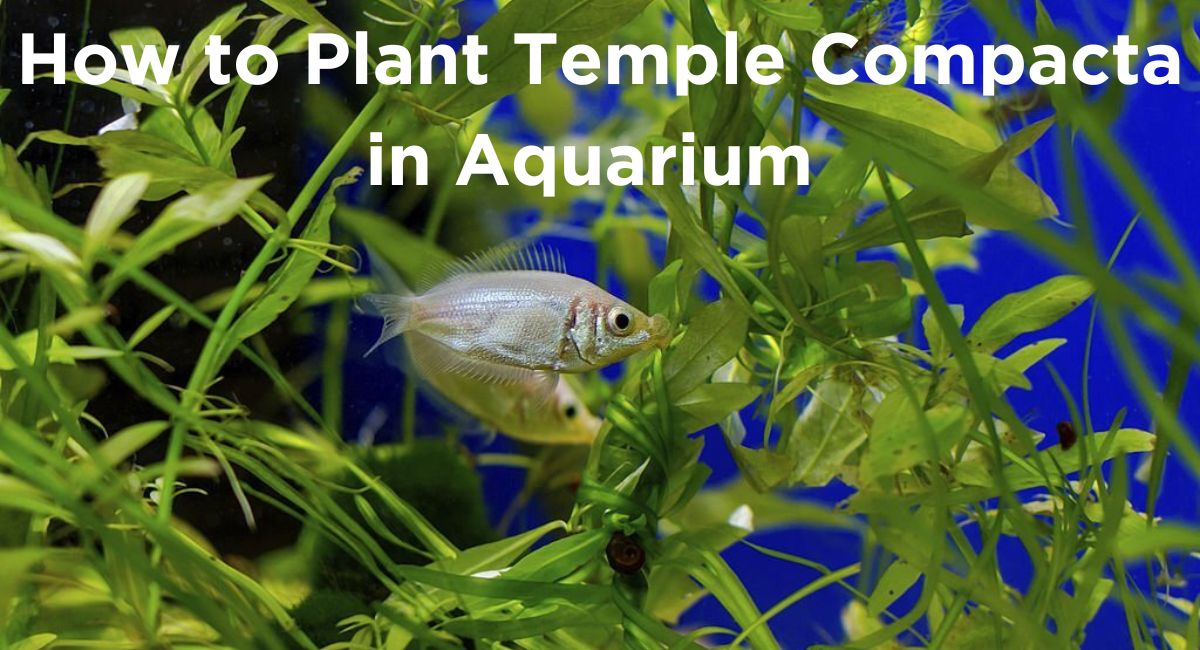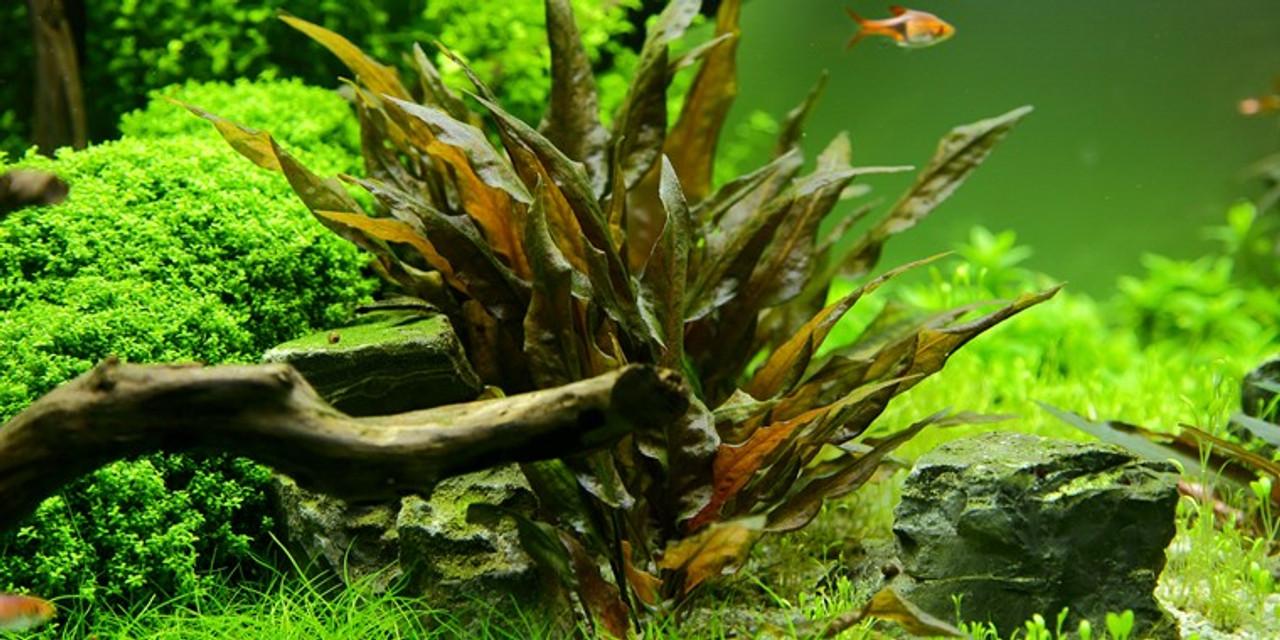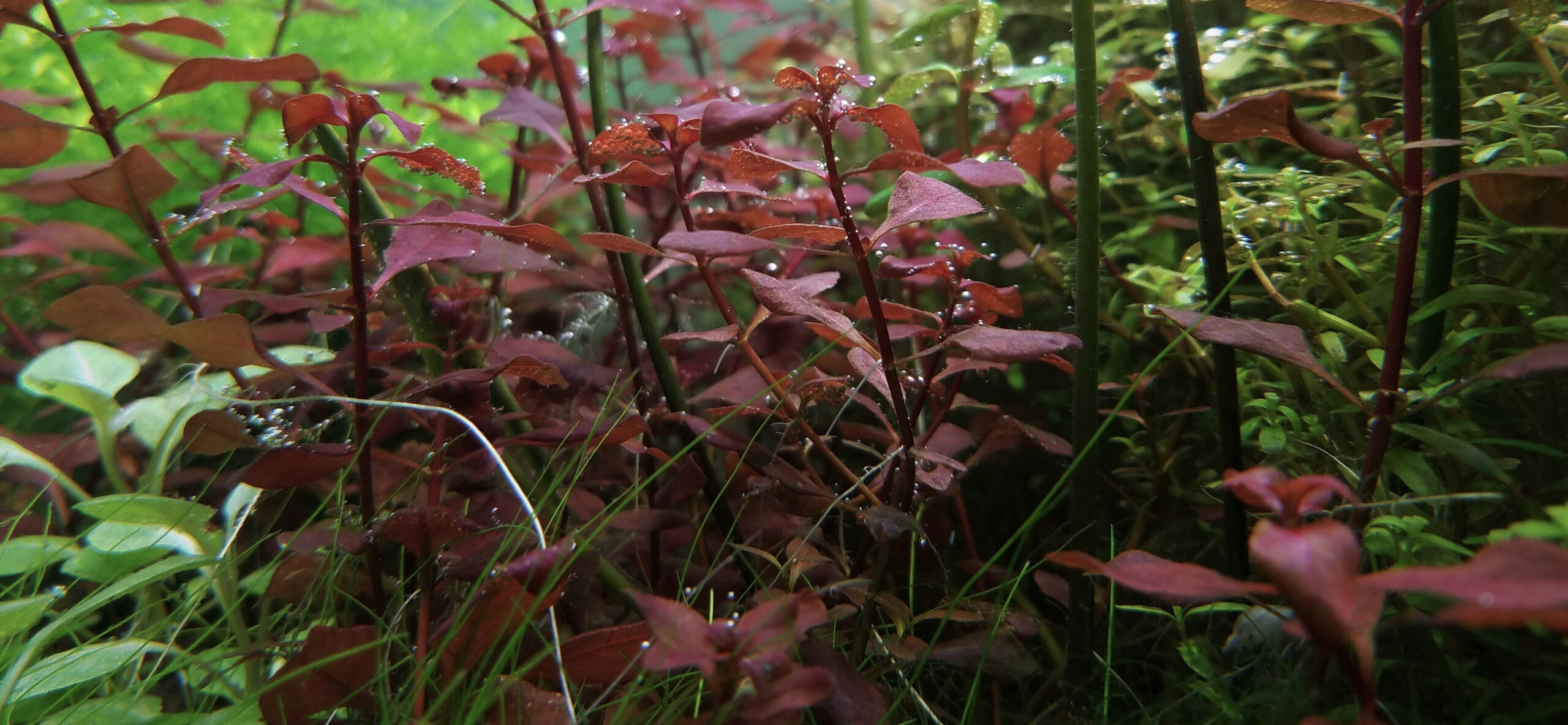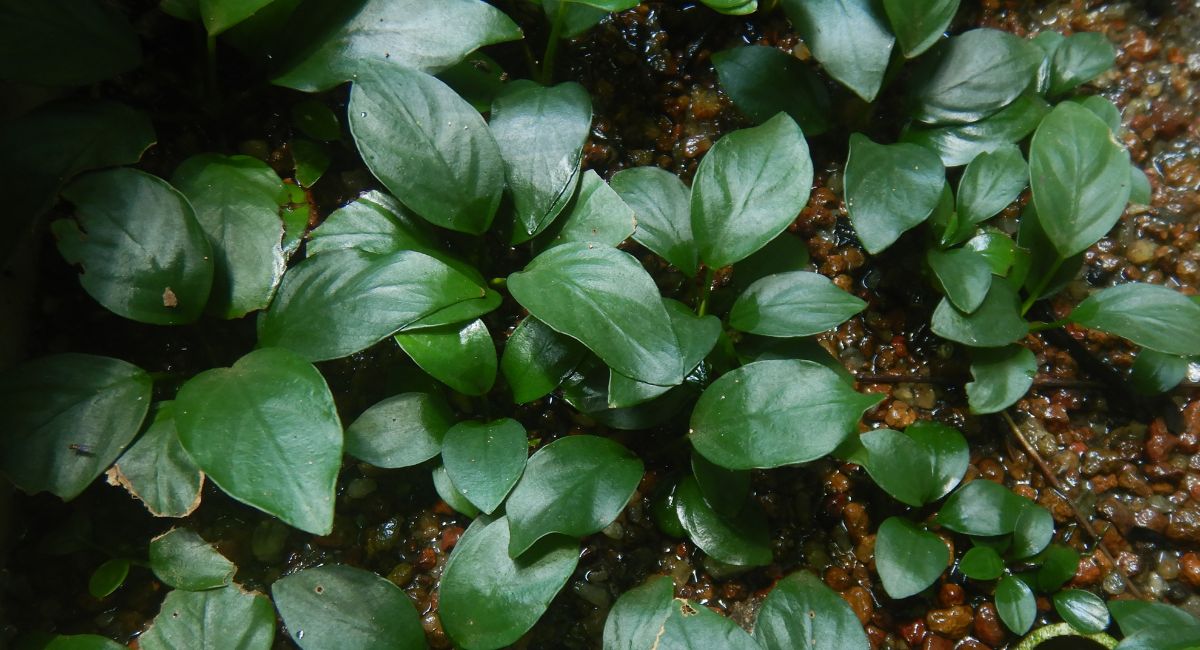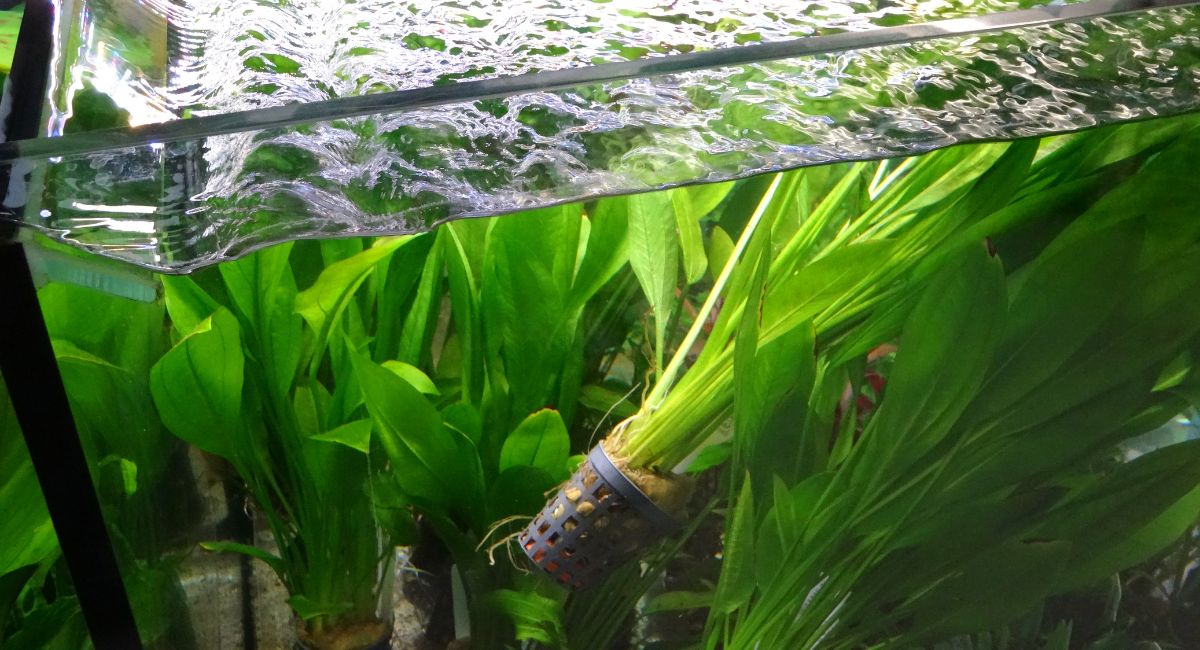Smartplantedaquarium.com participates in affiliate marketing programs. We may earn commissions on purchases made through our affiliate links. This doesn't affect our content or recommendations and we only recommend products we would put in our own tanks.
Creating a vibrant and thriving aquatic environment in your aquarium can be a rewarding and visually stunning experience. One plant that can truly elevate the beauty of your underwater landscape is the Temple Compacta (Scientific name: Alternanthera reineckii ‘Mini’). This eye-catching aquatic plant is a favorite among aquarists for its stunning red hues, compact size, and easy maintenance.
Whether you’re a seasoned aquarium enthusiast or just starting your journey into the world of aquascaping, learning how to plant and care for Temple Compacta will undoubtedly add a touch of elegance to your underwater world.
Get ready to dive into the mesmerizing world of Temple Compacta as we delve into the intricacies of this remarkable aquatic plant and learn how to transform your aquarium into a captivating underwater oasis.
Contents
- Overview of Temple Compacta
- Benefits of Keeping Temple Compacta in Aquariums
- Required Equipment and Supplies
- How to Plant Temple Compacta in Aquarium
- Step 1 Prepare the Aquarium and Substrate
- Step 2 Planting Temple Compacta
- Step 3 Provide Suitable Lighting and CO2
- Step 4 Maintain and Care for Temple Compacta
- Step 5 Provide Proper Water Circulation and Filtration
- Step 6 Monitor and Adjust Water Parameters
- Step 7 Consider Tankmates Compatibility
- Step 8 Enjoy and Maintain Your Aquatic Oasis
- Mistakes to Avoid When Planting Temple Compacta
- How to Use Temple Compacta for Aquascaping
- Conclusion
- Frequently Asked Questions
Overview of Temple Compacta
Description and Appearance:
Temple Compacta, scientifically known as Alternanthera reineckii ‘Mini,’ is a striking and visually appealing aquatic plant that has become popular among aquarium enthusiasts. It belongs to the Amaranthaceae family and is native to South America. This compact variant of Alternanthera reineckii features vibrant red and pink hues in its leaves, making it a captivating addition to any aquarium.
The plant’s leaves are the highlight of its appearance, as they showcase a mix of red and pink shades with delicate, serrated edges. In ideal conditions, Temple Compacta can grow up to 3-6 inches (8-15 cm) in height, which makes it suitable for mid-ground or foreground placement in aquariums. Its compact size and rich coloration make it an excellent choice for creating contrast and adding visual interest to aquascapes.
Origin:
Temple Compacta, or Alternanthera reineckii ‘Mini,’ is native to the riverine regions of South America. Specifically, it is believed to originate from the areas surrounding the Amazon River and the Rio Grande do Sul region in Brazil. In its natural habitat, this plant thrives in marshy and semi-aquatic environments, where it receives adequate sunlight and nutrient-rich waters.
Different Types of Temple Compacta:
While the Temple Compacta (Alternanthera reineckii ‘Mini’) is one of the most popular variants, the broader Alternanthera reineckii species offers several other types with varying appearances and growth habits. Some of the notable variations include:
- Alternanthera reineckii (regular form): This variant typically displays more elongated leaves compared to the compact ‘Mini’ variety. Its foliage showcases a mix of green, red, and pink colors.
- Alternanthera reineckii ‘Rosanervig‘: This type features stunning pink veins on its leaves, adding an extra layer of visual appeal to aquariums.
- Alternanthera reineckii ‘Cardinalis’: Also known as ‘Cardinalis Pink,’ this variety stands out for its intensely pinkish-red foliage, creating a bold statement in aquascapes.
Benefits of Keeping Temple Compacta in Aquariums
Keeping Temple Compacta in aquariums offers numerous benefits, making it a popular choice among aquarists. Let’s explore some of the key advantages:
- Aesthetically Pleasing: Temple Compacta’s vibrant red and pink foliage adds a splash of color and beauty to any aquarium. Its striking appearance creates an eye-catching focal point and enhances the overall aesthetics of the tank.
- Easy Maintenance: Temple Compacta is relatively easy to care for, making it suitable for both beginner and experienced aquarium enthusiasts. It does not require high levels of CO2 supplementation and can thrive in moderate to high light conditions.
- Oxygen Production: Like all aquatic plants, Temple Compacta participates in photosynthesis, releasing oxygen as a byproduct. This helps maintain a healthy and well-balanced ecosystem for the fish and other aquatic inhabitants in the tank.
- Natural Habitat Simulation: The plant’s compact size and rich coloration mimic the appearance of various submerged vegetation found in natural aquatic environments. Keeping Temple Compacta in the aquarium helps create a more realistic and visually appealing underwater landscape.
- Water Filtration: Aquatic plants play a crucial role in water filtration by absorbing excess nutrients such as nitrates and phosphates from the water. This helps reduce algae growth and improves water quality, promoting a healthier environment for aquatic life.
- Habitat and Shelter for Fish: Temple Compacta provides a natural habitat and shelter for small fish and invertebrates in the aquarium. It offers hiding spots and resting places, reducing stress for the aquatic inhabitants.
- Algae Control: The dense growth of Temple Compacta can help shade areas of the aquarium, preventing excessive light exposure and controlling algae growth.
- Environmental Balance: Incorporating live plants like Temple Compacta in the aquarium creates a more balanced ecosystem. It helps establish a symbiotic relationship between plants and aquatic organisms, fostering a harmonious and natural habitat.
- Educational Value: Observing the growth and development of Temple Compacta in an aquarium can be a great learning experience, especially for children and students. It provides insights into the natural processes of plant growth and the interdependence of living organisms in an ecosystem.
- Stress Reduction: Studies have shown that the presence of live plants in an aquarium can have a calming effect on fish, reducing their stress levels and promoting better overall health.
Required Equipment and Supplies
To successfully plant and maintain Temple Compacta in your aquarium, you will need several essential equipment and supplies. Here’s a comprehensive list to help you get started:
| Equipment/Supply | Purpose |
|---|---|
| Aquarium Tank | Provide a habitat for Temple Compacta and fish |
| Aquarium Substrate | Nutrient-rich base for plant growth |
| Aquarium Filter | Maintain water quality |
| Aquarium Lighting | Support plant photosynthesis |
| CO2 System | Enhance plant growth (high-tech setups) |
| Water Conditioner | Remove chlorine and chloramine from water |
| Aquarium Heater | Maintain tropical water temperature (if needed) |
| Planting Tools | Ease of planting and maintenance |
| Fertilizers | Provide essential nutrients for plants |
| Algae Scrubber/Pad | Keep the aquarium glass clean |
| Gravel Vacuum | Facilitate water changes and debris removal |
| Water Testing Kits | Monitor water parameters for plant health |
| Net | Safely transfer plants and fish during upkeep |
- Aquarium Tank: Choose a suitable aquarium tank based on the number of plants you intend to keep and the available space. Ensure it has a secure lid to prevent fish from jumping out and to reduce evaporation.
- Aquarium Substrate: Use a nutrient-rich substrate specifically designed for aquatic plants. This will provide essential nutrients for the growth of Temple Compacta and other plants in your aquarium.
- Aquarium Filter: A quality aquarium filter is crucial for maintaining water quality. It helps remove debris, excess nutrients, and waste, keeping the aquarium environment healthy for both plants and fish.
- Aquarium Lighting: Select appropriate aquarium lighting to support plant growth. LED lights with adjustable intensity and color temperature are commonly used to cater to different plant species’ light requirements.
- CO2 System: While not mandatory, a CO2 injection system can enhance the growth and coloration of Temple Compacta. This is especially beneficial in high-tech planted aquarium setups.
- Water Conditioner: Use a water conditioner to remove chlorine and chloramine from tap water before adding it to the aquarium. This ensures the water is safe for both plants and fish.
- Aquarium Heater (If needed): If you plan to keep tropical aquarium plants, including Temple Compacta, a heater may be necessary to maintain the water temperature within the appropriate range.
- Aquarium Test Kits: Invest in test kits to monitor water parameters such as pH, ammonia, nitrite, and nitrate levels. Regular testing helps ensure optimal water quality for the plants and aquatic inhabitants.
- Planting Tools: Tweezers or long-handled scissors are helpful for planting and maintaining Temple Compacta in the aquarium without disturbing the substrate or other plants.
- Fertilizers: Consider using liquid or root tab fertilizers specifically formulated for aquatic plants. These supplements provide essential nutrients that may not be readily available in the aquarium water.
- Algae Scrubber or Pad: To keep the aquarium glass clean and free from algae, have an algae scraper or pad on hand for regular maintenance.
- Gravel Vacuum: A gravel vacuum facilitates water changes and helps remove accumulated debris from the substrate, ensuring a cleaner and healthier aquarium environment.
- Water Testing Strips: For quick and convenient water testing, you may opt for water testing strips in addition to liquid test kits.
- Net: Keep a soft, fine-meshed net nearby for safely transferring plants and fish during maintenance.
How to Plant Temple Compacta in Aquarium
By following these steps, you can successfully plant and care for Temple Compacta in your aquarium, creating a captivating and vibrant underwater landscape that will delight both you and your aquatic inhabitants Regular care and attention will ensure a stunning and rewarding aquarium experience for both you and your aquatic companions:
Step 1 Prepare the Aquarium and Substrate
- Clean the Tank: Thoroughly clean the aquarium tank, removing any dust, dirt, or residues. Rinse the tank with water, but avoid using soap or harsh chemicals that could harm your aquatic plants and fish.
- Add Substrate: Pour a nutrient-rich aquarium substrate into the tank. Spread it evenly to create a level surface, ensuring it’s deep enough to accommodate the root system of Temple Compacta.
- Moisten the Substrate: Before planting, moisten the substrate slightly to help anchor the plants and prevent them from floating or shifting during planting.
- Create a Planting Plan: Plan the placement of Temple Compacta in your tank. Consider the plant’s growth habits and height to achieve an aesthetically pleasing layout. Mixing it with other aquarium plants can create an attractive contrast and provide variety.
Step 2 Planting Temple Compacta
- Prepare the Plants: Gently remove Temple Compacta from its pot and carefully untangle or trim any overly long roots. This will encourage healthy growth when planted in the aquarium.
- Planting Technique: Using planting tweezers or your fingers, create small holes in the substrate to accommodate the roots of Temple Compacta. Insert the plant into the hole and gently press the substrate around the roots to secure it in place.
- Plant in Groups: Plant Temple Compacta in clusters or groups rather than individually. This creates a more natural and visually appealing arrangement while encouraging growth and providing hiding places for fish.
- Spacing: Ensure adequate spacing between each plant to allow room for growth. Overcrowding can lead to competition for resources and may hinder the plants’ development.
Step 3 Provide Suitable Lighting and CO2
- Select Proper Lighting: Temple Compacta thrives under moderate to high light conditions. Choose LED lights with adjustable intensity to meet the plant’s light requirements. Aim for 8-10 hours of light per day.
- Consider CO2 Injection: In high-tech planted aquarium setups, supplementing with CO2 can boost growth and coloration. A CO2 injection system can be beneficial for Temple Compacta and other demanding plants.
- Monitor Light Duration: Avoid excessive light exposure, as it may promote algae growth. Use a timer to maintain a consistent light cycle and prevent disruptions to the aquarium’s ecosystem.
- Observe Plant Response: Regularly monitor the plants’ response to light and CO2. Adjust the lighting and CO2 levels as needed based on the growth and coloration of Temple Compacta.
Step 4 Maintain and Care for Temple Compacta
- Watering Schedule: Temple Compacta is an aquatic plant, and it obtains nutrients through its roots. Ensure the aquarium is filled with water, and the substrate remains moist at all times.
- Fertilization: Supplement the aquarium with liquid or root tab fertilizers to provide essential nutrients that may be lacking in the water. Follow the recommended dosing instructions to avoid over-fertilization.
- Pruning: Regularly trim any yellow or damaged leaves to maintain the plant’s health and appearance. Pruning also encourages new growth and prevents the plant from becoming too dense.
- Maintain Water Quality: Conduct regular water tests to monitor parameters like pH, ammonia, nitrite, and nitrate levels. Perform water changes as needed to maintain a clean and stable environment for the plants and fish.
Step 5 Provide Proper Water Circulation and Filtration
- Install Aquarium Filter: Choose an appropriate filter system that matches the size of your aquarium. The filter helps maintain water circulation, removes debris, and supports the growth of beneficial bacteria that aid in biological filtration.
- Position the Filter Outflow: Position the filter outflow strategically to ensure even water flow throughout the tank. Avoid directing the flow directly onto Temple Compacta to prevent dislodging the plants or causing damage to delicate leaves.
- Regular Filter Maintenance: Clean the filter media regularly according to the manufacturer’s recommendations. Regular maintenance ensures the filter operates efficiently, providing optimal water quality for the plants and aquatic life.
- Use a Circulation Pump (Optional): In larger aquariums, consider using a circulation pump to enhance water movement and prevent stagnant areas. Proper water circulation helps distribute nutrients and CO2 more evenly to the plants.
Step 6 Monitor and Adjust Water Parameters
- Temperature Control: Maintain the water temperature within the recommended range for Temple Compacta, typically between 72°F to 82°F (22°C to 28°C), depending on the species.
- pH Levels: Check the pH levels regularly to ensure they fall within the suitable range for the plant, which is typically between 6.0 to 7.5.
- Ammonia and Nitrate Levels: Keep a close eye on ammonia and nitrate levels, as high levels can be harmful to both plants and fish. Perform water changes as needed to keep these parameters in check.
- Adjust Water Parameters as Necessary: If the water parameters deviate from the ideal range for Temple Compacta, make appropriate adjustments using water conditioners or other suitable products. Be cautious not to make sudden or drastic changes, as it may stress the plants and fish.
Step 7 Consider Tankmates Compatibility
- Research Compatible Fish and Invertebrates: Ensure that the fish and invertebrates you plan to keep in the aquarium are compatible with Temple Compacta. Some fish may nibble on the plant’s delicate leaves, while others may benefit from its hiding spots.
- Avoid Plant-Damaging Species: Some species, particularly herbivorous fish or snails, may pose a threat to Temple Compacta. Choose tankmates that are not known to eat or damage aquatic plants.
- Observe Interactions: Monitor the behavior of tankmates after introducing Temple Compacta. If you notice any issues, consider rearranging the aquarium layout or choosing alternative species to ensure the well-being of the plants.
- Create a Harmonious Community: By selecting appropriate tankmates, you can establish a harmonious aquatic community where Temple Compacta can thrive alongside other fish and invertebrates.
Step 8 Enjoy and Maintain Your Aquatic Oasis
- Regular Observation: Spend time observing your Temple Compacta and other aquarium inhabitants regularly. This allows you to notice any changes or signs of stress, disease, or nutrient deficiencies in the plants.
- Prune and Rearrange: Periodically prune and rearrange the plants in the aquarium to maintain the desired layout and prevent overgrowth or overcrowding.
- Learn and Adapt: Continuously learn about the care needs of Temple Compacta and other plants in your aquarium. Adapt your maintenance routine and care practices based on your observations and acquired knowledge.
- Appreciate the Beauty: Take time to appreciate the beauty of your aquatic oasis. The vibrant colors and dynamic growth of Temple Compacta and other plants contribute to a captivating and visually appealing underwater world.
Mistakes to Avoid When Planting Temple Compacta
Avoiding common mistakes during the planting process can significantly contribute to the success and health of Temple Compacta in your aquarium. Here are some key mistakes to be mindful of:
| Mistake | Impact |
|---|---|
| Improper Planting Depth | Hindered growth and nutrient absorption |
| Overcrowding | Competition for resources, stunted growth |
| Neglecting Water Quality | Detrimental effects on plants and fish |
| Insufficient Lighting | Weak, leggy growth, loss of vibrant colors |
| Lack of Nutrients | Stunted growth, poor health |
| Ignoring CO2 Requirements | Limited development and coloration potential |
| Skipping Quarantine | Introduction of pests or diseases |
| Using Medications Without Research | Harm to aquatic plants |
| Ignoring Compatibility with Tankmates | Damage to leaves, stress on plants |
| Drastic Changes in Parameters | Shock and stress on Temple Compacta |
| Pruning Too Aggressively | Weakening of the plant’s health |
| Neglecting Regular Maintenance | Unhealthy and unbalanced aquarium ecosystem |
- Improper Planting Depth: Planting Temple Compacta too deep or too shallow in the substrate can hinder its growth and nutrient absorption. Ensure the roots are adequately covered, but avoid burying the entire plant. Aim to keep the crown of the plant just above the substrate surface.
- Overcrowding: Planting Temple Compacta too close together or overcrowding the aquarium can lead to competition for resources like light and nutrients. Provide sufficient spacing between each plant to allow for healthy growth and prevent shading issues.
- Neglecting Water Quality: Poor water quality can have detrimental effects on Temple Compacta and other aquatic life. Avoid neglecting water changes and maintaining the filter. Regularly test water parameters to address any issues promptly.
- Insufficient Lighting: Temple Compacta requires moderate to high lighting for optimal growth and coloration. Inadequate light can result in weak, leggy growth and loss of vibrant colors. Invest in suitable LED lights to support the plant’s light requirements.
- Lack of Nutrients: Temple Compacta is a nutrient-hungry plant, and neglecting to provide essential nutrients can result in stunted growth and poor health. Supplement the aquarium with appropriate fertilizers to meet the plant’s nutritional needs.
- Ignoring CO2 Requirements: In high-tech planted aquarium setups, carbon dioxide (CO2) injection can significantly benefit Temple Compacta’s growth. Neglecting to provide adequate CO2 can limit the plant’s development and coloration potential.
- Skipping Quarantine: Introducing new plants or aquarium inhabitants without quarantine can lead to the introduction of pests or diseases. Quarantine new plants before adding them to the main aquarium to prevent potential contamination.
- Using Medications Without Research: Be cautious when using medications or treatments in the aquarium. Some medications can harm aquatic plants, including Temple Compacta. Research and choose plant-safe options when necessary.
- Ignoring Compatibility with Tankmates: Some fish and invertebrates may harm Temple Compacta by nibbling on its delicate leaves. Avoid keeping plant-damaging species with your Temple Compacta to prevent unnecessary stress on the plants.
- Drastic Changes in Parameters: Sudden and drastic changes in water parameters, such as temperature, pH, or hardness, can shock and stress Temple Compacta. Always make gradual adjustments when necessary.
- Pruning Too Aggressively: While pruning is essential for maintenance, avoid pruning Temple Compacta too aggressively. Removing too many leaves at once can weaken the plant and hinder its ability to photosynthesize.
- Neglecting Regular Maintenance: Regular maintenance, including water changes, substrate cleaning, and pruning, is vital for the overall health of your aquarium. Neglecting these tasks can lead to an unhealthy and unbalanced ecosystem.
How to Use Temple Compacta for Aquascaping
Using Temple Compacta for aquascaping can enhance the visual appeal and create a captivating underwater landscape. Here are some tips on how to incorporate Temple Compacta effectively into your aquascape:
- Placement: Temple Compacta’s vibrant colors and compact size make it an excellent choice for mid-ground or foreground placement in the aquarium. Arrange the plants in clusters or groups for a more natural look.
- Contrasting Colors: Consider pairing Temple Compacta with plants that have contrasting colors, such as green or yellow varieties. This contrast will add depth and visual interest to the aquascape.
- Creating Focal Points: Use Temple Compacta as a focal point in the aquascape. Plant it in a strategic location, such as the center of the aquarium, to draw attention and create a striking focal area.
- Background Variety: For a captivating background, mix Temple Compacta with taller and larger plants like Amazon Swords or other stem plants. This combination will create a lush and dynamic backdrop for the aquarium.
- Texture Variation: Introduce plants with different leaf textures and shapes to complement Temple Compacta’s appearance. Plants like Java Moss or Anubias with contrasting textures can add a unique dimension to the aquascape.
- Driftwood and Rocks: Incorporate driftwood or rocks in the aquascape to provide support for Temple Compacta or to create natural-looking borders around the plant clusters.
- Balanced Layout: Balance the arrangement of plants to avoid overcrowding and ensure each species has sufficient space to grow and develop without shading one another.
- Regular Maintenance: Keep Temple Compacta and other plants well-maintained by trimming and pruning as needed. This will prevent excessive growth and maintain the desired shape and appearance of the aquascape.
- Foreground Carpet: Utilize Temple Compacta in the foreground to create a carpet effect when planted close together. Combine it with low-growing carpeting plants for a lush and visually appealing foreground.
- Aquarium Lighting: Ensure proper lighting to support the growth and coloration of Temple Compacta. Use LED lights with adjustable intensity to meet the plant’s light requirements.
Conclusion
Throughout this article, we have explored the essential aspects of successfully planting Temple Compacta in your aquarium. From choosing the right substrate and lighting conditions to understanding the ideal water parameters and propagation techniques, these considerations play a crucial role in the overall health and growth of the plant.
Temple Compacta’s unique appearance and low-maintenance nature make it an ideal addition to any aquarium. Its lush green foliage and compact size create a striking focal point that adds a sense of serenity to the aquatic environment. Moreover, its ability to provide hiding spots and shelter for fish and other aquatic creatures promotes a harmonious ecosystem within the tank.
Planting Temple Compacta in your aquarium can elevate the aesthetics of your tank, support a healthier aquatic ecosystem, and offer a rewarding and enriching experience for aquarium enthusiasts. By following the steps outlined in this article and nurturing the plant with care, you can create a vibrant and captivating underwater paradise that brings joy and tranquility to both you and your aquatic inhabitants. Happy planting!
Frequently Asked Questions
1. What are the best companion plants for Temple Compacta?
To create a visually appealing aquascape, you can pair Temple Compacta with various other aquatic plants. Some great companion plants include Ludwigia sp., Rotala sp., Cryptocoryne sp., and Eleocharis sp. (Dwarf Hairgrass). Combining different plant shapes, colors, and heights can add depth and complexity to the aquarium.
2. What are the best tank mates for Temple Compacta?
Temple Compacta is a popular aquarium plant known for its vibrant red and pink colors. It can coexist well with various peaceful community fish species like tetras, rasboras, gouramis, and small catfish. Avoid pairing it with aggressive or herbivorous fish that may damage the delicate foliage. Shrimps and snails are generally compatible tank mates for Temple Compacta as well.
3. How fast does Temple Compacta grow?
The growth rate of Temple Compacta is considered moderate to fast in the right conditions. Under optimal care, it can grow at a rate of approximately 2 to 3 inches (5 to 7.5 centimeters) in height per month. Adequate lighting, nutrient-rich substrate, and regular fertilization contribute to its faster growth.
4. How big does Temple Compacta grow?
Temple Compacta, as the name suggests, is a compact variant of the Alternanthera reineckii plant. It typically grows to a height of around 4 to 6 inches (10 to 15 centimeters) in an aquarium setting. Its relatively small size makes it an excellent choice for foreground or midground planting in aquascapes.
5. Is Temple Compacta suitable for beginners?
Temple Compacta is considered moderately suitable for beginners. While it is not the most challenging plant to grow, it does require some experience and attention to detail. Providing it with proper lighting, nutrient supplementation, and CO2 (carbon dioxide) injection, if possible, can significantly improve its growth and coloration. Beginners who are willing to learn and experiment with plant care can successfully keep Temple Compacta with some research and effort.
6. Is Temple Compacta suitable for a low-tech aquarium?
Temple Compacta can survive in a low-tech aquarium with moderate lighting and nutrient availability. However, to achieve its vibrant colors and optimal growth rate, it benefits from moderate to high lighting and a nutrient-rich substrate. While CO2 injection is not strictly necessary, it can enhance the plant’s growth and appearance. Therefore, while Temple Compacta can be grown in a low-tech setup, it may not exhibit its full potential without some additional care and resources.
